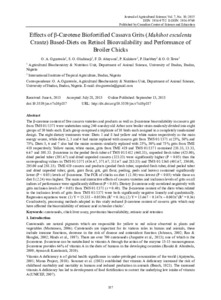| dc.contributor.author | Ogunwole, A.O. |
| dc.contributor.author | Oladimeji, S.O. |
| dc.contributor.author | Abayomi, F.D. |
| dc.contributor.author | Kulakow, P.A. |
| dc.contributor.author | Iluebbey, P. |
| dc.contributor.author | Tewe, O.O. |
| dc.date.accessioned | 2019-12-04T10:58:17Z |
| dc.date.available | 2019-12-04T10:58:17Z |
| dc.date.issued | 2015 |
| dc.identifier.citation | Ogunwole, O.A., Oladimeji, S.O., Abayomi, F.D., Kulakow, P., Iluebbey, P. & Tewe, O.O. (2015). Effects of B-carotene biofortified cassava grits (Mahihot esculenta Crantz) based-diets on retinol bioavailability and performance of broiler chicks. Journal of Agricultural Science, 7(10), 187. |
| dc.identifier.issn | 1916-9752 |
| dc.identifier.uri | https://hdl.handle.net/20.500.12478/957 |
| dc.description.abstract | The B-carotene content of five cassava varieties and products as well as B-carotene bioavailability in cassava grit from TMS 01/1371 were undertaken using 240 one-day old Arbor acre broiler strain randomly divided into eight groups of 30 birds each. Each group comprised a triplicate of 10 birds each assigned in a completely randomized design. The eight dietary treatments were: Diets 1 and 8 had yellow and white maize respectively as the main energy source, while diets 2, 3 and 4 had maize replaced with cassava grit from TMS 01/1371 at 25%, 50% and 75%. Diets 5, 6 and 7 also had the maize contents similarly replaced with 25%, 50% and 75% grits from TME 419 respectively. Yellow maize, white maize, grits from TME 419 and TMS 01/1371 contained 238.33, 13.33, 6.67 and 108.33. B-carotene in the peeled fresh tuber of TMS 01/1412 (468.33), unpeeled fresh tuber (425.00), dried peeled tuber (391.67) and dried unpeeled cassava (323.33) were significantly higher (P < 0.05) than the corresponding values in TMS 01/1371 (416.67, 371.67, 311.67 and 283.33) and TMS 01/1368 (401.67, 350.00, 295.00 and 258.33). TME 419 cassava and products (peeled fresh tuber, unpeeled fresh tuber, dried peeled tuber and dried unpeeled tuber, garri, garri flour, grit, grit flour, peeling, peels and leaves) contained significantly lower (P < 0.05) levels of B-carotene. The FCR of chicks on diet 1 (1.50) was lowest (P < 0.05) while those on diet 8 (2.24) was highest. The main and interactive effects of cassava varieties and inclusion levels of grits on all indices of performance were significantly different (P < 0.05). Dietary B-carotene only correlated negatively with grits inclusion levels (P < 0.05) from TMS 01/1371 (r = 0.40). The B-carotene content of the diets when related to the inclusion levels of grits from TMS 01/1371 were both significantly negative linearly and quadratically. Regression equations were: (1) Y = 15.333 – 0.0530x (R2 = 0.16); (2) Y = 13.667 + 0.147x – 0.003x2 (R2 = 0.36) Conclusively, processing methods adopted in this study reduced B-carotene content of cassava grits which may have affected the bioavailability of retinoic acid in broiler chicks’. |
| dc.format.extent | 187-197 |
| dc.language.iso | en |
| dc.subject | Carotenoids |
| dc.subject | Cassava |
| dc.subject | Maize |
| dc.subject | Bioavailability |
| dc.title | Effects of β-carotene biofortified cassava grits (Mahihot esculenta Crantz) based-diets on retinol bioavailability and performance of broiler chicks |
| dc.type | Journal Article |
| dc.description.version | Peer Review |
| cg.contributor.crp | Roots, Tubers and Bananas |
| cg.contributor.affiliation | University of Ibadan |
| cg.contributor.affiliation | International Institute of Tropical Agriculture |
| cg.coverage.region | Africa |
| cg.coverage.region | West Africa |
| cg.coverage.country | Nigeria |
| cg.authorship.types | CGIAR and developing country institute |
| cg.iitasubject | Biofortification |
| cg.iitasubject | Cassava |
| cg.iitasubject | Maize |
| cg.journal | Journal of Agricultural Science |
| cg.howpublished | Formally Published |
| cg.accessibilitystatus | Open Access |
| local.dspaceid | 77577 |
| cg.targetaudience | Scientists |
| cg.identifier.doi | https://dx.doi.org/10.5539/jas.v7n10p187 |

